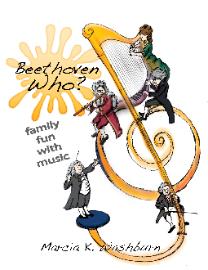Beethoven Who? Family Fun with Music presents a great introductory music education for all ages, and it’s not just about Beethoven. It comes as a PDF book via digital download or on a CD-ROM. You need to read the file on a device with an internet connection since the book is heavily reliant on internet links. It has loads of YouTube video links and other internet sites as well as links to other locations within the book itself. Be sure to note what page you are on before clicking a link that takes you elsewhere in the book itself since you might have trouble finding your place again in this giant 334-page book! This isn’t an issue with the internet links since those open in your browser without losing your place.
The book has an introduction and four sections: Listening to Music, Reading Music, Making Music, and Appendices.
The first section, Listening to Music, begins with a chapter titled “The Elements of Music.” This chapter and chapter eight are dryer than the rest of the course. The purpose of the first chapter is to teach some basic musical vocabulary such as melody, harmony, rondo, sonata, concerto, prelude, and percussion. Words are linked to definitions or examples within the book, but they are not linked to the internet. It seems to me that you would do just as well to start into chapter two with the “Getting Started” listening activities on page 30, then jump into the third chapter. The vocabulary terms come up frequently with hot links to the glossary. (Again, make sure you don’t lose your place if you jump to these links.) Some terms are explained as they are used, and you won’t need to go to the glossary. Probably most important is that children will be listening and watching musical performances that give them experiential ways of understanding many of the terms.
Chapters three through seven introduce students to classical music in a huge variety of formats, many of which will delight even reluctant listeners. The presentation works chronologically through musical periods from the Baroque period through the twentieth century. In these chapters covering musical periods, brief biographical information leads directly into discussion of each of the composer’s works. These discussions link to examples to view as various techniques or musical pieces are highlighted. The text sometimes refers to specific time markers on videos to watch for particular movements or events in a performance. This helps focus students’ attention much more than just listening. The integration of the information with the experience of listening and viewing musical performances makes this a very effective way to teach music appreciation. Both parents and children will likely appreciate seeing and hearing examples immediately when they are discussed. And parents should appreciate not having to search out musical works on their own.
It is impossible with this type of project to keep all of the links current all of the time since they are controlled by others. I found some broken links as I worked through some of the lessons. But there are so many links that I didn’t feel like I was missing anything critical with the occasional broken link. Parents should check out all links just before using a lesson if possible. Pre-select links you think will be most interesting to your children.
The second section, Reading Music, begins in chapter eight with a lesson on how to read music. You can skip this chapter if you are not concerned that your children learn to read music at this point. But if you choose to teach it, be sure to use the companion games and activities in chapter nine that make it much more fun to learn musical notation. Chapter ten teaches children to recognize pitch. Chapter eleven teaches rhythm, and chapter twelve teaches dynamics. Each of these chapters includes multi-sensory games and/or activities for learning. You might teach these three chapters even if you skip chapters eight and nine.
Section three, Making Music, is all about songs. First are traditional American folk songs with a list of songs with which the author believes children should become familiar. Links are included to sites with some songs and related activities as well as to Wee Sing that sells CDs with many of these songs. Second, are action songs, with directions for the actions for many of the standard songs...along with lyrics. Next is a chapter on “Love and Friendship” songs such as “Down in the Valley.” The book continues with songs about animals, work songs, patriotic songs, and sacred songs. Background explanations and weblinks are occasionally included.
Chapter 21 presents creative ideas for “Sharing Your Music with Others.” Examples of the ideas are presenting a music report and serving high tea while listening to Handel’s “Water Music.”
You can skip around in the book to some extent. In fact, on page 14, author Marcia Washburn encourages you to “mix in listening lessons from Sections I and III with the hands-on activities in Section II.” She also explains on that same page that “Chapters 1 and 8 are more instructional in nature and are designed to support other chapters."
Be sure to read the Introduction before starting the course, especially the section of the introduction titled “How to Use This Book.” Once you’ve got a sense of what is included within the course, you should feel free to work through it however works best for you. For example, if you have young children, you might want to start with action and rhythm songs from the third section, while if you have older children, you might want to start with the classical composers and their works. You might complete Section I in a year, working through lessons in chronological order, but other sections of the book give you so much musical material to work with that you could spend years working through various sections as you and your children learn to enjoy and make music together.








